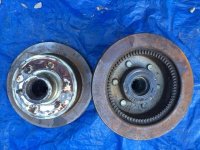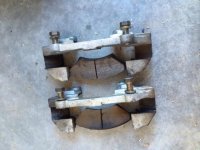Pat Anderson
New member
So, today I got my hands dirty!
Two threads you should look at for the run-up to this one!
First, my thread about Bearing Buddies and bearings in general and then Localboy Mark's tutorial on bearing maintenance.
I have Bearing Buddies, and was having some problems with them, namely, the plate was not moving when it was supposed to, so I probably blew the rear seals when I kept pumping grease.
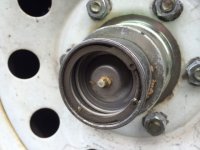
Today I jacked up one side of the boat, and determined for sure that I have bearing problems (grinding noise) on both wheels on that side. So I decided today was the day to pull the hubs.
I followed Localboy Mark's tutorial to the degree I could, but I soon found that our hubs and brakes were drastically different, even though we both had King Saltwater trailers of approximately the same vintage. The difference, I suspect, is due to all the work we had done over the years, most recently in 2014 just before we left for Lake Powell.
First problem was getting the dang Bearing Buddies off, I finally figured out that I was just too timid. After ruining my HF deadblow hammer, I finally got an old fashioned claw hammer and beat the crap out of them and they came off!
Here is the hub right after the rims were removed.
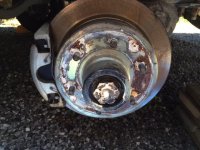
Per Mark, the first thing you do is remove the brake caliper by removing two studs. That is where I could see my boat had different brakes entirely. The studs on my brake calipers have Allen heads:
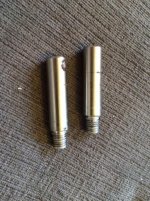
[ing]http://www.c-brats.com/albums/album2159/Allen_head_on_brake_caliper_stud.jpeg[/img]
Mark has you removing studs and then the brake caliper and rotor. My studs were completely different, and the brake caliper was actually in two parts, one bolted to the suspension and the other mounted in the first part. So removing the caliper did not allow removal of the rotor!
So after I got the brakes off, both parts, the rest was pretty easy. i don't know how easy it will be to put it all back together however!
So here is where we are at the end of the day today.
http://www.c-brats.com/albums/album2159/Hubs.jpeg[img]
[img]http://www.c-brats.com/albums/album2159/Spindles.jpeg
A fork in the road, now do I (A) rebuilt the hubs myself or (B) take them to Circle A Trailers for the rebuild? My choice is B for now, now enough time to mess things up!
Two threads you should look at for the run-up to this one!
First, my thread about Bearing Buddies and bearings in general and then Localboy Mark's tutorial on bearing maintenance.
I have Bearing Buddies, and was having some problems with them, namely, the plate was not moving when it was supposed to, so I probably blew the rear seals when I kept pumping grease.

Today I jacked up one side of the boat, and determined for sure that I have bearing problems (grinding noise) on both wheels on that side. So I decided today was the day to pull the hubs.
I followed Localboy Mark's tutorial to the degree I could, but I soon found that our hubs and brakes were drastically different, even though we both had King Saltwater trailers of approximately the same vintage. The difference, I suspect, is due to all the work we had done over the years, most recently in 2014 just before we left for Lake Powell.
First problem was getting the dang Bearing Buddies off, I finally figured out that I was just too timid. After ruining my HF deadblow hammer, I finally got an old fashioned claw hammer and beat the crap out of them and they came off!
Here is the hub right after the rims were removed.

Per Mark, the first thing you do is remove the brake caliper by removing two studs. That is where I could see my boat had different brakes entirely. The studs on my brake calipers have Allen heads:

[ing]http://www.c-brats.com/albums/album2159/Allen_head_on_brake_caliper_stud.jpeg[/img]
Mark has you removing studs and then the brake caliper and rotor. My studs were completely different, and the brake caliper was actually in two parts, one bolted to the suspension and the other mounted in the first part. So removing the caliper did not allow removal of the rotor!
So after I got the brakes off, both parts, the rest was pretty easy. i don't know how easy it will be to put it all back together however!
So here is where we are at the end of the day today.
http://www.c-brats.com/albums/album2159/Hubs.jpeg[img]
[img]http://www.c-brats.com/albums/album2159/Spindles.jpeg
A fork in the road, now do I (A) rebuilt the hubs myself or (B) take them to Circle A Trailers for the rebuild? My choice is B for now, now enough time to mess things up!


